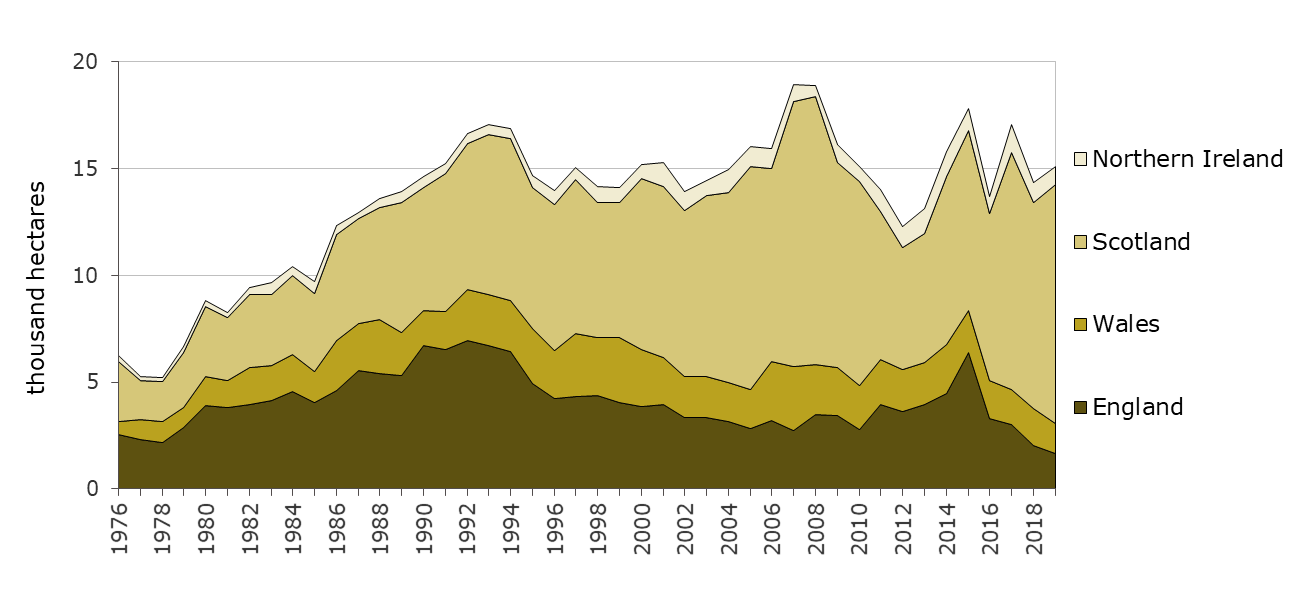We use some essential cookies to make this website work.
We’d like to set additional cookies to understand how you use forestresearch.gov.uk, remember your settings and improve our services.
We also use cookies set by other sites to help us deliver content from their services.
Figure 1.6 shows areas of new planting by country since the year ending March 1976. Trends in new planting rates have been influenced by changes to the incentives available to landowners (in the form of grants and regulations).
In recent years, areas of new planting in the UK have dropped to lows of under 6 thousand hectares in 2009-10 and in 2015-16 and have risen to highs of around 13 thousand hectares in 2011-12, 2013-14 and 2018-19. These fluctuations are likely to have been influenced by changes in grant schemes across the UK.
At 13.4 thousand hectares in 2018-19, the current level of new planting represents a 47% increase from the 9.1 thousand hectares achieved in the previous year and continues the increase from 2015-16. This increase was largely in Scotland and was likely to have been influenced by the availability of grant funding and increased confidence in forestry arising from strong timber values. For further information, see the New Planting and Restocking section of the Sources chapter.

Source: Forestry Commission, Forestry England, Scottish Forestry, Forestry and Land Scotland, Natural Resources Wales, Forest Service, grant schemes.
Notes:
1. Private sector figures are based on grant-supported new planting and (where possible) with estimates for areas planted without grant aid.
2. Figures for grant-aided planting relate to areas for which grants were paid during the year.
3. Estimates for areas planted without grant aid are believed to be under-reported and, as a result, the reported figures are likely to under-estimate the true level of planting activity. For England, woodland planting funded by sources other than the Countryside Stewardship Woodland Creation Grant include planting supported by the Woodland Trust, by the Environment Agency, by Natural England and land acquired by the National Forest Company. For Scotland, a small amount of new planting without grant aid was included for 2016-17 and 2018-19.
4. The planting season lies both sides of 31 March, and the weather can cause planting to be advanced or delayed.
5. Includes woodland formed by natural colonisation (where known).
Figure 1.7 shows reported areas of restocking by country since the year ending March 1976. It indicates an increase in restocking rates during the period. Over the same period, there has been a general increase in UK wood production (see UK-Grown Timber chapter).
The reported area of restocking fell significantly after a peak of 19 thousand hectares in 2006-07. This followed changes to grant support for restocking in Scotland, that resulted in some non-grant aided Sitka spruce restocking being excluded from the estimates. Results from the Forestry Commission’s Nursery Survey (an annual survey of forest nurseries in Great Britain) indicate that, following a dip in the 2009/10 planting year, sales of Sitka spruce plants to Scotland have been relatively stable in recent years.
The chart shows a dip in the area of restocking in 2015-16, following changes to grant schemes across the UK. Reported restocking has continued to fall in England, where grant aid is now only available in very limited circumstances. The reported area of publicly funded restocking in the UK in 2018-19 represents a 5% increase from the previous year, but remains below the level reported for 2016-17. For further information, see the New Planting and Restocking section of the Sources chapter.

Source: Forestry Commission, Forestry England, Scottish Forestry, Forestry and Land Scotland, Natural Resources Wales, Forest Service, grant schemes.
Notes:
1. Private sector figures are based on areas for which grants were paid during the year.
2. Estimates of areas planted without grant aid are also included (where possible) up to 2009-10, but no estimates are available since then. As a result, the reported figures are likely to under-estimate the true level of planting activity.
3. The planting season lies both sides of 31 March, and the weather can cause planting to be advanced or delayed.
4. Includes woodland restocked by natural regeneration.
5. Restocking by natural regeneration in non-clearfell areas may be under-represented.
Sources chapter: New planting & restocking
Cookies are files saved on your phone, tablet or computer when you visit a website.
We use cookies to store information about how you use the dwi.gov.uk website, such as the pages you visit.
Find out more about cookies on forestresearch.gov.uk
We use 3 types of cookie. You can choose which cookies you're happy for us to use.
These essential cookies do things like remember your progress through a form. They always need to be on.
We use Google Analytics to measure how you use the website so we can improve it based on user needs. Google Analytics sets cookies that store anonymised information about: how you got to the site the pages you visit on forestresearch.gov.uk and how long you spend on each page what you click on while you're visiting the site
Some forestresearch.gov.uk pages may contain content from other sites, like YouTube or Flickr, which may set their own cookies. These sites are sometimes called ‘third party’ services. This tells us how many people are seeing the content and whether it’s useful.